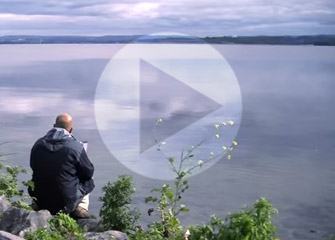Members of the Onondaga Lake Conservation Corps Construct, Install, and Survey Habitat Structures and Bird Boxes along the Western Shoreline of Onondaga Lake
Volunteers gathered along the Onondaga Lake western shoreline on Saturday, June 18, to build, install, and survey habitat structures as they participated in citizen science monitoring. The volunteers are part of the Onondaga Lake Conservation Corps, an expanding organization of community volunteers who are contributing to restoration projects that are creating or improving wildlife habitat in the Onondaga Lake watershed.

Left: Corps volunteers install coverboards on the western shoreline. Coverboards are used for surveying amphibian and reptile communities. They create a moist area that attracts insects and provides protection for many salamander, frog, and snake species.
“Amphibians and reptiles are important parts of functioning ecosystems. It’s great to see how the newly constructed wetlands have been designed with this in mind,” said Peter Ducey, Ph.D., a professor and herpetologist in the Biological Sciences Department at the State University of New York Cortland, pictured above (far right), speaking with volunteers at the event. “These animals are visible and audible indicators of recovering wetlands – basking turtles and calling frogs show visitors that these habitats are thriving. The success of the many habitats associated with Onondaga Lake will ultimately depend on people in the community understanding and taking pride in this great resource.”

“It was great to volunteer with the Onondaga Lake Conservation Corps,” said 15-year-old Corps member Mackenzie Fassett, pictured above surveying a bird box with her dad, Ron Fassett. “I was excited to learn about the cleanup and all of the wildlife returning to Onondaga Lake.”

Corps volunteers construct, install, and survey wooden bird boxes. At an event in May 2015, the Corps installed 24 bird boxes. At the June event, Corps members surveyed the previously installed bird boxes to see if they are being utilized and if the boxes need to be cleaned.
Left: Two-year-old JJ, of North Syracuse, New York, helps build a bird box.
Right: Corps member Douglas Beauchamp, of Altmar, New York, surveys a previously installed bird box.

Watch a video about the Onondaga Lake Conservation Corps.
The work along the lake’s western shoreline will transform 20 acres into new wetlands and improved habitat for wildlife that will play a significant role in creating a healthy Onondaga Lake watershed and a sustainable ecosystem. On the shores of Onondaga Lake and along the lake’s tributaries, Honeywell is improving a total of 87 acres of wetlands and planting about 1.1 million plants, shrubs, and trees. To date, more than 420,000 shrubs and trees have been planted. More than 50 acres of wetlands have been restored.

Left: Corps members Janna, Autumn, Evelyn, and Nate Keefe, of Syracuse, track native birds on a birding walk along Onondaga Lake’s western shoreline. In total, 37 bird species were identified during the event.
Right: Josh Zhao, Jing Wang, and Richard Blankenship, of Fayetteville, New York, work with Montezuma Audubon Center Director Chris Lajewski to install bird boxes.

Since the formation of the Corps in summer 2012, more than 600 volunteers have become environmental stewards and Corps members. In recognition of their work, the Onondaga Lake Conservation Corps was awarded a U.S. Environmental Protection Agency 2015 Environmental Champion Award.
The Corps seeks to inspire future stewards of Onondaga Lake and its watershed through a hands-on, experience-based program that offers citizens and organizations the opportunity to participate in activities that help restore and sustain Onondaga Lake and its value as an Important Bird Area.
To learn more about the Onondaga Lake Conservation Corps or participate in future activities, please contact montezuma@audubon.org or call 315-365-3588. Schools, community groups, local organizations and individuals are welcome. Like the Corps on Facebook or visit YouTube to learn more.
For more information on the Onondaga Lake cleanup, visit www.lakecleanup.com.
For more photographs of the Onondaga Lake Conservation Corps, click here.














































